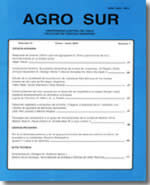Effect of conventional agricultural practices upon the biodiversity of edaphic mesofaunistic groups in a prune plantation. an agroecological approach
Main Article Content
Abstract
The aim of the study was to evaluate the effect of some conventional agricultural practices upon the biodiversity of edaphic mesofaunistic groups. The study was conducted in a prune plantation located in Sagrada Familia, Curicó, which had received urea fertilization as well as glyphosate application for weed control over 15 years. Five 10x10x10 cm random soil samples were collected from the prune plantation and from a naturalized grassland used as a control, and placed in modified Berlesse-Tulgren systems for seven days. The soil fauna were then identified and quantified using a Nikon stereomicroscope using a magnification of 40x. The composition of the fauna, its diversity by means of the Shanon-Winner index (H’), the homogeneity (J) of each community and the taxonomic similarities through the Jaccard (Sj) and Winer (Sw) indexes, were determined.
It was concluded that the extended use over time of these agricultural practices bring about a disturbance of the ecosystem structure demonstrated by a decrease in the number of specimens and taxonomic richness, with Acarina and Collembola the most affected edaphic groups.

